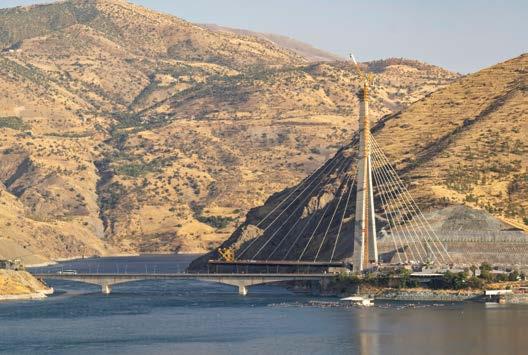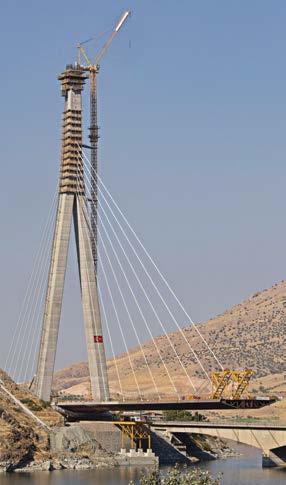
7 minute read
Bridges in Focus
BUILDING BRIDGES IN THE AFTERMATH OF THE BUSHFIRE CRISIS
Between September 2019 to March 2020, bushfires burnt over 18.6 million hectares across Australia. The path of destruction has left towns desperately trying to pick up the pieces of their communities. Homes, buildings and infrastructure are now beginning to be rebuilt after the damage.
Advertisement
For many regional towns, bridges are the only ways in or out of their community. When a bridge has been damaged, the impact on the local community can be significant, particularly if the bridge is one of only a handful of access points connecting the region.
Bridges form a vital part of Australia’s transport network, with around 30,000 timber road bridges in service throughout the country. However, due to heavier and faster moving vehicles and more recently, damage by bushfires, many of these ageing timber structures have deteriorated or damaged beyond repair and Councils are needing to look at ways to reconstruct the infrastructure with a time and budget effective solution.
As a way to extend the life of existing timber bridges or build replacement bridges, Australian timber specialist and plywood manufacturer, Big River Group, has developed an engineered timber system consisting of bridge decking, girders, headstocks and corbels along with many other engineered sections that replace existing timbers size for size, a structural grade Engineered plywood bridge deck system which acts as an alternative to steel and concrete decks being less expensive, faster to install, and a critical measure of success for those locations who are lacking council funding and are needing a quick
response. The system is an Engineered substitute for traditional hardwood decking and is manufactured to AS/NZS 2269-2008 from sustainable Australian plantation pine. The key feature of the Big River Engineered Bridge Decking is the it is manufactured in continuous lengths to the full width of a bridge hence providing excellent load distribution utilising the full structure and extensively extending the life of existing structures when used as a deck replacement. When the fully Engineered system is used with the combination of Engineered LVL: girders, headstocks and corbels etc this delivers a full Bridge system that complies with loadings and AS:5100 T44 deflection limits as well as M1600. As a retrofit solution that can help extend the life of timber bridges by decades, Bridge ply, offers a low-cost option for rehabilitating existing, older timber structures without needing to replace the entire bridge – meaning only components that are failing need to be replaced, saving time and material costs. Cedar Creek Bridge, in the Hunter region of New South Wales, was restored in three days – four days ahead of deadline, with council contracting two work crews aroundthe-clock to complete the job quickly.
The larger size of Bridge ply helps to absorb much of the extra vibration of heavy vehicles while also tying together the other timber components of the bridge better than solid hardwood planks. What’s more, the material holds fire resistant qualities which have the ability to withstand temperatures that reach 1,000°C for up to 50 minutes. Providing a time efficient solution due to its lightweight feature, Bridge ply can be moved in large sections with the same machinery used for alternative materials, so less trucks are required for delivery and less crane movement is needed in order to connect the components. Additionally, as a timber-based product, most of the machinery alterations, can be done on site with hand tools, such as drilling. All of these benefits, together with its lightweight material, means installation can occur in a timely manner with minimal disruption to the local community. Big River Group are offering drop-in services and temporary bridges for immediate solutions to reconnect communities, whilst strengthening and recovering existing timber bridge assets quickly and within council budget. For more information visit: www.bigrivergroup.com.au/product/ structural-plywood-bridge-decking

ABOUT BIG RIVER GROUP Big River Group manufactures and distributes timber and steel formwork products, timber flooring, structural plywood and related timber products, and distributes a broad range of other building products, including MaxiWall and MaxiFloor, primarily to the commercial and residential, non-residential and infrastructure construction market segments. Big River owns and manages 17 sales and distribution outlets including Sydney, Gold Coast, Brisbane (2), Sunshine Coast, Townsville, Illawarra, Melbourne, Canberra, Geelong, Adelaide, Perth and New Zealand. The Company also owns and operates manufacturing facilities at Grafton and Wagga Wagga in NSW, Geelong, Perth and Auckland NZ. Big River provides customers with the security of a full support network, and technical expertise at every stage of the product lifecycle. This is the guarantee of quality and service that Big River has based its 110 years of success on.
BUILDING A NEW ICON – TURKEY’S NEW KÖMÜRHAN BRIDGE

Constructed over the Karakaya Dam Lake, the Kömürhan Bridge will soon forge part of the Malatya-Elazig State highway in Eastern Turkey. Measuring 600 metres in length, the bridge features a cable-stayed design with a single pylon, which stands at 165 m in height. This special type of bridge, which is the fourth single pylon cable-stayed bridge in the world, will also serve an important regional role as a logistics corridor, not only connecting Malatya and Elazığ, but also serving as a strategic crossing for the 16 provinces of Eastern Anatolia.
Located approximately 700 kilometres east of the Turkish capital of Ankara and 400 kilometres north of the Syrian border lies the province of Malatya, a region famed for its apricots and now the tallest pylon in the country.

Standing at a height of 168.5 metres, the ‘Y’ shaped reinforced concrete tower is the centrepiece of the new Kömürhan Bridge. Doka’s Automatic Climbing Formwork SKE 50 was used on the upper single core column of the pylon. ©2020 Doka
The Kömürhan Bridge, with 660 m length and 360 m span, is designed as cable-stayed. It will be connected to the pylon with 42 tensioned cables. ©2020 Doka
Standing at a height of 168.5 metres, the ‘Y’ shaped reinforced concrete tower is the centrepiece of the new Kömürhan Bridge, a suspension structure traversing the Fırat River and the Malatya-Elazığ regional borders. Stretching just over half a kilometre at 660 metres the bridge has an edge opening of 180 metres, a middle opening of 380 metres and a width of 24 metres. The deck cross-section will be orthotropic steel, while the superstructure of the bridge will be connected to the pylon with 42 tensioned cables. In context of the wider project, it is part of a 5,225 metres four-lane highway that includes a 120-metre viaduct and a 2,400 metres tunnel, providing passage to the Karakaya Dam a few kilometres to the south. The existing old bridge and crookedly connected roads will be preserved. The new bridge and the tunnel will be developed next to the existing route. It is planned that the Kömürhan Bridge is scheduled to be completed in July 2020.
Working under the joint venture of Doğuş and Gülsan, Doka Turkey was awarded the contract to design and supervise the execution of formwork, which commenced in August 2017. With the bridge scheduled to open in 2020, we spoke with project manager, Mr. Taha Özdilek, who commented on his experience with Doka Turkey.
“Safety was our main priority on this project and Doka has maintained an excellent track record where this is concerned. Most of my team were accustomed with Doka’s products and systems and knew that the solution presented, and the site support received would add much value. Our team was also familiar with Doka’s solution for a similar project (Nissibi Bridge), which was delivered in 2015 and therefore knew they would be well suited for the job.”
In terms of the practical formwork solution, the major challenge was focused on the pylon, specifically its unusual shape. Doka’s Automatic Climbing Formwork SKE 50 was used on the upper single core column of the pylon, while a specially adapted double set was used on the lower half with bespoke solutions created at junction points to maintain the highest standards of quality and safety. Largearea formwork Top 50 was used for the pylon with Doka D2/D3 and Load-bearing Towers Staxo 100 shoring systems for the approaching viaduct. While a tower and mobile crane were used for the pylon and viaduct respectively, the formwork solution was otherwise self-sufficient and delivered its portion of the project safely, on time and on budget.
QUICK FACTS Project: Kömürhan Bridge Location: Malatya-Elazığ, Turkey Type of Structure: Cable-Stayed Bridge Length: 660 metres Main Span: 360 metres Height of Pylon: 165 metres Concrete: 160,000 m³ Reinforcement: 6,000 tons Developer: Republic of Turkey General Directorate of Highways (KGM) Contractor: Doğuş and Gülsan Holding Systems Used: Automatic Climbing Formwork SKE 50, Large-area formwork Top 50, Load-bearing tower Staxo 100, Load-bearing Tower d3
ABOUT DOKA Doka is a world leader in developing, manufacturing and distributing formwork technology for use in all fields of the construction sector. With more than 160 sales and logistics facilities in over 70 countries, Doka has a high-performing distribution network which ensures that equipment and technical support are provided swiftly and professionally. An enterprise forming part of the Umdasch Group, Doka employs a worldwide workforce of 7,000.










